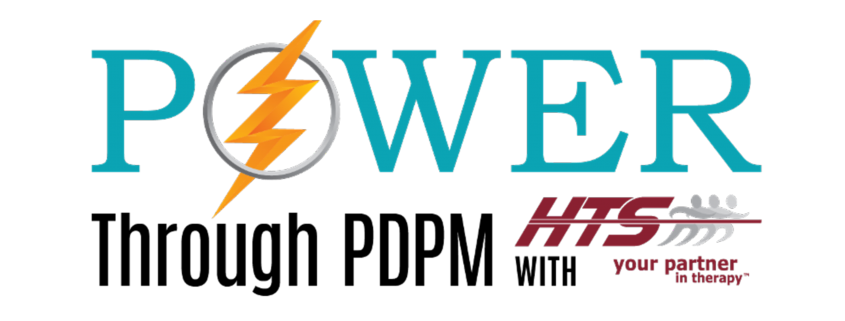What Therapists Need to Know About PDPM
PDPM replaces the RUG-IV system beginning 10/1/19. The methodology for determining payment shifts from resource usage (or amount of services provided) to patient characteristics. Currently, under RUG-IV, there are 3 components: Nursing, Therapy, and Non-Case Mix. PDPM is meant to be “Budget-Neutral” and breaks the per diem payment into 6 components: Nursing, Non-Therapy Ancillary, PT, OT, SLP, and Non-Case Mix. Each of the 6 components creates a per diem amount. The sum of all 6 components establishes the total per diem rate of reimbursement.
Calculation of Per Diem Rate
PT and OT are calculated by first determining the clinical category (based on the primary ICD-10 code entered on the MDS). Next, the functional score is determined based on Section GG coding on the 5-day assessment (functional areas used for scoring include: eating, oral hygiene, toilet hygiene, bed mobility items, transfer items, and walking items). These criteria result in a PT and an OT case-mix group which then correlates to a PT and an OT case-mix index. The CMI is then multiplied by the urban or rural federal rate per diem to establish the reimbursement rate for PT and OT. Additionally, a variable per diem adjustment is applied to both PT and OT after day 20. Beginning with day 21, a 2% reduction is applied every 7 days. Up to 25% of the total therapy provided is permitted to be in group or concurrent (25% per discipline).
SLP is calculated by first determining if the clinical category is acute neurologic or non-neurologic based on the ICD-10 diagnoses coded on the MDS. Other factors include whether there is a presence of cognitive impairment, any SLP co-morbidities, swallowing disorder, or an altered diet. These criteria result in a SLP case-mix group which correlates with a SLP case-mix index. The CMI is then multiplied by the urban or rural federal rate per diem to establish the reimbursement rate for SLP. There is no variable per diem adjustment applied to SLP. Up to 25% of therapy is permitted to be group or concurrent.
Nursing is calculated very similarly as to how it is calculated now under RUG-IV. Under PDPM, the 43 Nursing RUGs are collapsed into 25 classifications. Several Nursing RUGs are combined into 1 PDPM Nursing case-mix group. Additionally, the function score for nursing will use Section GG (instead of Section G). In contrast to the RUG-IV ADL scoring, the PDPM function score assigns higher points to higher levels of Independence. Additionally, an 18% increase in the nursing per diem will be applied for patients with HIV/AIDS as coded on the SNF claim. No variable per diem adjustment is applied to Nursing.
Non-Therapy Ancillary (NTA) is calculated by assigning points to specific patient conditions and services based on MDS coding and from data on the claim. The total number of points obtained results in a NTA case-mix group which correlates to a NTA case-mix index. The CMI is then multiplied by the urban or rural federal per diem rate to establish the reimbursement for NTA. A variable per diem adjustment of X 3 is applied to days 1-3, and beginning on day 4, the rate returns to the base NTA CMI with no further adjustment.
Non-Case Mix remains as currently calculated under RUG-IV.
The per diem amount for each component is summed for the total per diem rate.
Additional Elements to PDPM
MDS Assessments: PDPM requires only 5-Day and Discharge Assessments. The 5-Day Assessment drives reimbursement for the duration of the stay. SOT’s, COTS, and EOTS are eliminated. The new Discharge Assessment adds multiple therapy details as a means for CMS to monitor provider behavior changes (specifically reduction of therapy services) and to oversee the amount of group and/or concurrent therapy provided. CMS indicates that provider behavior changes and exceeding the 25% limit for group/concurrent may result in reviews, denial of coverage, and/or policy changes. An Interim Payment Assessment (IPA) is added as an optional assessment that providers may elect to perform if a patient’s condition changes to the extent that reimbursement would be modified.
Interrupted Stay: The interrupted stay rule applies when a patient discharges from the SNF, but returns to the same SNF within 3 days. When this occurs, the stay resumes using the original 5-Day assessment results. No new MDS is completed. The variable per diem adjustments do NOT re-set. If a patient returns after 3 days, a new MDS is completed and a new stay is initiated. If a patient admits to a different SNF, a new MDS is completed and a new stay is initiated. The discharge destination is not a factor for applying the interrupted stay rule.
General Projections of Impact
While PDPM is intended to be budget-neutral, providers may experience varying levels of reimbursement impact. Based on CMS provided data using FY 2017 claims, broad generalization may be applied with the following characteristics most likely to generate increased reimbursement levels: shorter length of stays, smaller facilities, non-profit organizations, rural facilities, higher nursing needs (Extensive Services), prevalence of conditions requiring expensive medications, and moderate-to-lower levels of therapy intensity. Specifically, providers with a large volume of Ultra High level of therapy will likely see a decrease in reimbursement under PDPM. Providers who have historically provided moderate therapy intensity while achieving excellent outcomes will be the winners under PDPM.
Provider Impact and Operational Success
Timely and accurate processes are critical to successful operation under PDPM. The 5-Day assessment determines the case-mix classifications (or reimbursement) for the entire stay. Providers need to provide extensive training for accurate ICD-10 coding as the clinical category is a primary factor for CMI for Nursing, PT, OT, SLP, and NTA.
Additionally, Section GG coding directly impacts the functional score element for the PT, OT and Nursing Case-Mix Groups. Comprehensive training and auditing to ensure accurate coding for these items will aid in capturing the precise functional statuses for calculation of the CMIs. With this fundamental change in methodology, SNFs need to collaborate closely with their software provider to confirm functionality and utilize all available tools. Additionally, partnering with your therapy provider to implement processes and practices for best outcomes will secure your position in the market.
The SNF VBP and QRP mandates continue under PDPM. Clinical programs that cater to the needs of the residents you serve will result in reduced hospital re-admissions, improved quality measures, and higher star ratings. Through detailed analysis of the provider-specific impact files published by CMS using FY 2017 claims, SNFs can identify areas for improvement, implement enhanced programs and processes to promote success under PDPM.










Leave a Reply
Want to join the discussion?Feel free to contribute!